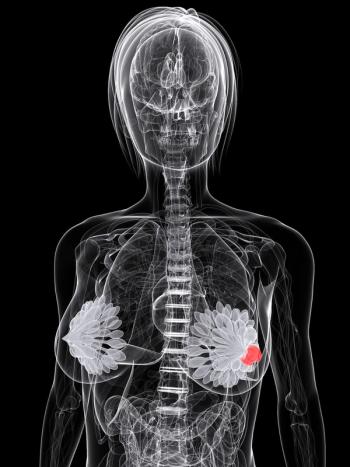
Patients With Esophageal Squamous Cell Carcinoma Treated With Frontline Toripalimab Plus Chemo Derive Survival Benefit
Results from the phase 3 JUPITER06 trial demonstrated positive outcomes with toripalimab plus platinum-based chemotherapy in patients with treatment-naïve advanced or metastatic esophageal squamous cell carcinoma.
An overall survival boost in previously untreated patients with advanced or metastatic esophageal squamous cell carcinoma (ESCC) was observed with the addition of toripalimab to platinum-based chemotherapy across all PD-L1 expression levels, according to data of an interim analysis from the phase 3 JUPITER06 study (NCT03829969) that were presented at the
Toripalimab plus chemotherapy reduced the risk of progression by 42% compared with placebo (HR, 0.58; 95% CI, 0.461-0.738; P < .00001). Specifically, the median progression-free survival in the toripalimab arm (n = 257) was 5.7 months (95% CI, 5.6-7.0) vs 5.5 months (95% CI, 5.2-5.6) in the placebo arm (n = 257).
The median overall survival (OS) for patients treated with the combination was 17.0 months (95% CI, 14.0-not estimable [NE]) compared with 11.0 months (95% CI, 10.4-12.6) for those who received placebo (HR, 0.58; 95% CI, 0.425-0.783; P = .00036).
“These results from JUPITER06 support the use of toripalimab in combination with [paclitaxel and cisplatin] as a new standard of care for the first-line treatment for advanced or metastatic ESCC,” said Feng Wang, MD, PhD, professor and vice director in the Department of Medical Oncology at Sun Yet-Sen University Cancer Center in Guangzhou, China.
Investigators enrolled 514 patients with treatment-naïve advanced or metastatic ESCC who had not received prior chemotherapy to receive paclitaxel and cisplatin with either toripalimab or placebo. Individuals were randomized 1:1 to receive 240 mg toripalimab or placebo
in combination with paclitaxel (175 mg/m2) plus cisplatin (75 mg/m2) once every 3 weeks for up to 6 cycles, followed by toripalimab or placebo maintenance. Patients were treated until progressive disease, intolerable toxicity, or withdrawal of consent/investigator judgement for up to 2 years.
Patients were stratified by prior radiation (yes vs no) and ECOG performance status (0 vs 1).
The coprimary end points were PFS by independent central review per RECIST v1.1 and OS. Secondary end points included PFS by investigator analysis, objective response rate, duration of response, disease control rate, 1- and 2-year PFS and OS rates, safety, and health-related quality of life.
Baseline characteristics were well balanced between the cohorts. The median age in the toripalimab arm was 63.0 years (range, 20-75), 74.3% of patients had an ECOG performance status of 1, and a majority of patients had metastatic disease (80.2%). In the placebo cohort, the median age was 62.0 years (range, 40-74), 74.7% had an ECOG performance status of 1, and 77.0% had metastatic disease. Recurrent or unresectable disease was observed in 19.5% and 23.0% of patients in the toripalimab and placebo arms at baseline, respectively.
In terms of PD-L1 expression, most patients had a combined positive score (CPS) greater than or equal to 1. Specifically, for those in the toripalimab arm, 16.7% had CPS less than 1, 78.2% had CPS of at least 1, 50.2% had CPS less than 10, and 44.7% had CPS of at least 10. These rates were 17.1%, 77.8%, 57.2%, and 37.7% in the placebo arm, respectively. CPS was not available for 5.1% of patients in each arm.
Wang presented additional available efficacy data for the anti–PD-1 monoclonal antibody in the intention-to-treat population. Specifically, the 1-year PFS rate for patients in the toripalimab arm was 27.8% (95% CI, 20.4%-35.8%) vs 6.1% (95% CI, 2.2%-12.6%) in the placebo arm.
The 1-year OS rate in the toripalimab arm was 66.0% (95% CI, 57.5%-73.2%) vs 43.7% (95% CI, 34.4%-52.6%) in the placebo arm. Notably, the 2-year OS rate was NE (NE-NE) for those in the experimental arm compared with 17.5% (95% CI, 8.7%-28.9%) in the placebo arm.
In terms of PD-L1 expression, OS and PFS benefits were maintained in the stratified analysis. Specifically, in the PD-L1–high cohort (CPS ≥ 1), the median PFS was 5.7 months in the toripalimab arm (n = 201) vs 5.5 months in the placebo arm (n = 200; HR, 0.58; 95% CI, 0.444-0.751). In the PD-L1–low cohort (CPS < 1), the median PFS was 5.7 months vs 5.6 months with toripalimab (n = 43) and placebo (n = 44), respectively (HR, 0.66; 95% CI, 0.370-1.189).
The median OS for patients treated with toripalimab plus chemotherapy who had high PD-L1 expression was 15.2 months vs 10.9 months (HR, 0.61; 95% CI, 0.435-0.870). For those with low PD-L1 expression, the median OS was NE in the experimental arm vs 11.6 months in the placebo arm (HR, 0.61; 95% CI, 0.297-1.247).
“The incidence of treatment-related AEs [adverse effects] and fatal AEs were similar between the 2 groups,” Wang said. Specifically, the incidence of grade 3 or higher AEs was 64.6% with the addition of toripalimab to chemotherapy vs 56.0% with placebo; any grade AEs were reported for 97.3% of patients in each arm.
All-grade infusion-related reactions were similar between the 2 arms (3.5% and 3.1%, respectively). Two patients in the toripalimab arm experienced a grade 3 or higher infusion-related AE.
Any-grade AEs leading to treatment discontinuation occurred in 3.5% of patients in the toripalimab arm, 2.7% of which were grade 3 or higher. Two patients in the placebo arm discontinued because of AEs (0.8%), one of whom stopped treatment because of a grade 3 or higher AE.
Fatal AEs were reported for 1 patient in the toripalimab arm vs 3 patients in the placebo arm.
The incidence of immune-related AEs was higher in the toripalimab vs placebo (37.0%
vs 26.5%); grade 3 or higher immune-related AEs were 7.0% vs 1.6%, respectively. “The higher incidence of immune-related AEs in the toripalimab arm were expected,” Wang said, adding that they were manageable for immunotherapy.
“The most common AEs were hematologic toxicity,” Wang noted. In the safety analysis, the most common reported AEs (incidence ≥ 30%) were anemia, leukopenia, neutropenia, nausea, peripheral neuropathy, fatigue, decreased appetite, alopecia, and vomiting.
In July 2021, Junshi Bioscience, the developer of toripalimab, announced that the National Medical Products Administration of China accepted a supplemental new drug application based on data from the JUPITER06 study.2 In the United States, Junshi Biosciences and Coherus, the US-based developer, plan to submit a supplemental biologics license application in 2022 for the treatment of ESCC.3
References
- Xu RH, Wang F, Cui C, et al. JUPITER-06: a randomized, double-blind, phase 3 study of toripalimab versus placebo in combination with first-line chemotherapy for treatment naive advanced or metastatic esophageal squamous cell carcinoma (ESCC). Presented at: European Society for Medical Oncology Annual Congress 2021; September 16-21, 2021; virtual. Abstract 1373MO.
- Junshi Biosciences announces acceptance by NMPA of supplemental new drug application for toripalimab plus chemotherapy as first-line treatment for advanced or metastatic esophageal squamous cell carcinoma. News release. Junshi Biosciences; July 31, 2021. Accessed September 17, 2021. bit.ly/3CjgxFJ
- Coherus and Junshi Biosciences to present positive progression free survival and overall survival results from JUPITER-06, a phase 3 clinical trial evaluating toripalimab in combination with chemotherapy as first-line treatment for advanced esophageal squamous cell carcinoma. News release. Junshi Biosciences and Coherus; September 16, 2021. Accessed September 17, 2021. bit.ly/3hIUL6C
Newsletter
Stay up to date on recent advances in the multidisciplinary approach to cancer.

















































































